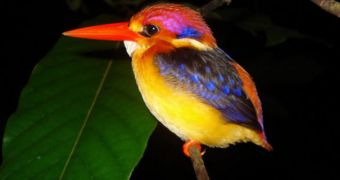Researchers have recently developed a new type of laser, one that can produce high-intensity laser light of almost any color by mimicking the nanoscale structure of colorful feathers found on some birds.
This advancement was made possible by the fact that researchers managed to master and replicate the way birds' feathers capture and reflect light. In the natural world, some birds and insects have such exquisite light-manipulation abilities that they are a constant source of inspiration for experts.
In the new investigation, researchers at the Yale University created a type of laser that used a new approach to creating light. The work was led by physicist Hui Cao and his colleagues, who published details of their accomplishment in the May 6 issue of the esteemed journal Physical Review Letters.
Lasers – devices that amplify light by stimulating the emission of radiation – work by focusing photons in or around materials that are capable of releasing the same types of light particles. This contributes to “amplifying” the light signal.
However, the problem with this is that the photons that need to be captured for this to happen have to endure for quite a long time in front of the emitting material. One way scientists went about fixing this issue was installing mirrors in front of said material, and bounced the photons between them.
Innovations along the way also saw experts place air holes in specialized glass, and construct mirrors from these materials. One of the issues that immediately arose was how to set up the holes, so that the photons would linger between the mirrors for a longer time?
Some teams tried creating entirely random hole patterns, whereas other created highly-ordered ones. However, both approaches were demonstrated to have some issues, such as complexity or cost.
In the new study, physicist Hui Cao combined both approaches and eliminated their weaknesses. He created an air hole setup in which the holes appear distribute randomly within the laser. However, on closer inspection, a small-scale pattern becomes apparent.
The team says that birds such as parrots feature the same type of arrangement. Studies conducted on the way their feathers are set up have demonstrated this in detail, Wired reports.
“After we learned this, we said, ‘Oh, that’s a smart idea!’ Can we use this to improve our lasers? May be we can use short-range order to enhance light confinement and make lasing more efficient,” Cao explains.
“Just like the birds, who can tune their short-range order to get different color from their feathers. We can do the same thing,” the expert says further, adding that studies should now be focused on determining how birds produce their feather arrangements.
“Birds seem to do it very cheaply. They have thousands of these feathers. If you can get these things to build themselves, taking the painstaking process out, then you’d barely have to put any energy and time into it,” says expert Matt Shawkey.
“It would be really cool to see which parameters the birds are changing to get these feathers to self-assemble,” adds the scientist, who is a biologist at the University of Akron in Ohio.

 14 DAY TRIAL //
14 DAY TRIAL //